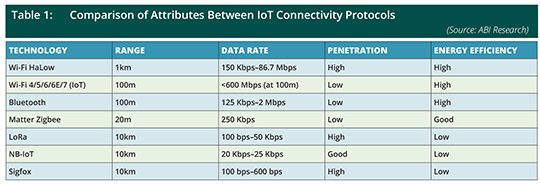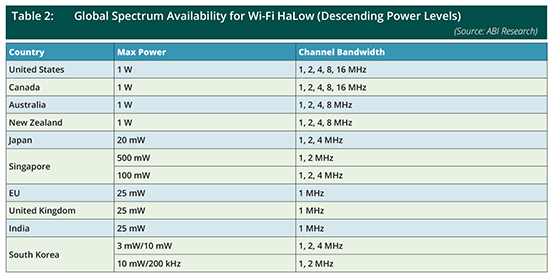What Does the First Wi-Fi Certified HaLow End-User Device Tell Us About the Fledgling Technology?
 By Andrew Spivey |
07 Feb 2023 |
IN-6824
By Andrew Spivey |
07 Feb 2023 |
IN-6824

Log In to unlock this content.
You have x unlocks remaining.
This content falls outside of your subscription, but you may view up to five pieces of premium content outside of your subscription each month
You have x unlocks remaining.
 By Andrew Spivey |
07 Feb 2023 |
IN-6824
By Andrew Spivey |
07 Feb 2023 |
IN-6824

Strategic Partnership to Deliver First Wi-Fi HaLow-Powered IP Camera |
NEWS |
In late January, leading Wi-Fi HaLow chipset manufacturer Morse Micro announced a new strategic partnership with Taiwanese consumer electronics manufacturer Chicony Electronics, in which they will together bring to market the industry’s first Wi-Fi HaLow consumer end-user device; an IP Camera. Wi-Fi HaLow will equip this IP Camera with ten times the reach of cameras relying upon traditional 2.4/5 GHz Wi-Fi, as well as ultra-low power consumption, enabling the batteries to last for years. Now that the first certified Wi-Fi HaLow consumer device has been unveiled, this insight evaluates the product’s significance and examines the clues it reveals as to where the industry is heading.
Why This Product and Why Now? |
IMPACT |
IP cameras, which transmit video footage via an IP network, demand internet connectivity with comparatively high throughputs (>2 Mbps) over mid-range distances (~50m), while also requiring high energy efficiency and security. Given these requirements, the decision to launch an IP camera as the first Wi-Fi HaLow End-User device was shrewd, as Wi-Fi HaLow is uniquely placed to deliver on them. Under optimal conditions Wi-Fi HaLow can achieve throughputs of 10 Mbps over ranges of 100m (with >80 Mbps at close-range and >150 kbps at distances of 1 km). In comparison, traditional Wi-Fi utilizing 2.4 GHz will be unable to connect to anything over 50m. Even for short distances, Wi-Fi HaLow’s utilization of the 900 MHz spectrum not only unlocks superior penetration abilities, but also the ability to avoid the heavily congested 2.4 GHz band. Although Wi-Fi HaLow faces stiff competition from alternative long-range Internet of Things (IoT) technologies for other IoT applications, in this case they are unable to provide the necessary IP video streaming properties of an IP camera. Furthermore, Wi-Fi HaLow can support the IP camera with key 802.11 features for energy-efficiency, such as Restricted Access Window (RAW), Target Wake Time (TWT), and MAC frame-shortening technology, as well as Wi-Fi grade security in WPA3.
The groundwork for the launch of this IP Camera has been laid over recent months. In September 2022 Morse Micro successfully raised US$94 million in their Series B funding round, followed by an additional US$20 million top-up from major Australian superannuation funds two month later. The success of the Series B funding round signified that the company had passed the development stage and proved to investors that its products had real market potential. The funding was intended to expand the market reach of Morse Micro. To this end Morse Micro concurrently entered into a strategic partnership with Japanese fabless company MegaChips (also an investor), which provided valuable sales support and new Asian distribution channels. September 2022 also saw the company receive certification from the FCC for their Wi-Fi HaLow SoC MM6108—the chipset which is powering the new IP Camera. Thus, the firm was ready to announce its first product, with an IP camera being the optimal choice as outlined above. Forming the partnership with Chicony for this venture was a natural fit as the company specializes in video-image equipment (as well as computer peripheral products), and has a strong global reach throughout the Americas, Europe, and Asia.
What Does the Future Hold for Wi-Fi HaLow? |
RECOMMENDATIONS |
On account of Wi-Fi HaLow’s unique attributes, there are certain connectivity demands which it is particularly well position to serve, and which other competing low-power connectivity solutions, both of the sort-range and wide-area variety, are unable to satisfy. IP cameras is perhaps the best use case in residential settings and, with this in mind, the IP Camera from Morse Micro and Chicony can be seen as a pilot device for the standard, designed to show the full potential of the new technology. But there are other promising applications in residential, such as for Wi-Fi HaLow to be leveraged as a replacement for cellular backhaul for devices outside the main home network. In practice, this could mean the delivery of firmware updates or the backup of video recordings for an automobile located in a garage. If the car garage or port where the vehicle was parked was positioned some distance from the house, say 20m, and obstructed by several objects including walls, Wi-Fi HaLow would not only be able to provide connectivity to the vehicle, but would still be able to achieve speeds greater than 2.5 Mbps. In contrast, 2.4 GHz technologies such as Bluetooth would be unable to serve in such a challenging environment, whereas other sub-1 GHz technologies could not provide the necessary throughput. Another area Wi-Fi HaLow could prove value is for IoT sensors scattered across the land of large properties, where it could still deliver >150kbps at ranges of 1 km. For context, performance over similar distances from long-range competitors like NB-IoT, LoRa, and Sigfox will be less than 1 kbps, whilst Bluetooth and Matter are unable to reach these distances. For a breakdown of the comparison between Wi-Fi HaLow and other key IoT connectivity protocols, see Table One.

In order for Wi-Fi HaLow to be ready to serve these environments, there must first be sufficient incorporation of the protocol into residential infrastructure to ensure compatibility. A small number of Internet Service Providers (ISPs) within the US and Europe are exploring the possibility of embedding Wi-Fi HaLow into their Customer Premise(s) Equipment (CPE), but no significant announcements have yet been made. There is great potential for Wi-Fi HaLow which should not be overlooked, especially in an environment where ISPs are increasingly looking to deploy more advanced equipment and introduce new value-services in order to bring product differentiation and improve their market competitiveness. For example, the ISP could offer both residential and business customers a package that includes a Wi-Fi HaLow embedded router or routers as well as Wi-Fi HaLow devices such as IP Cameras or smart home sensors. This would raise the value proposition of the ISP’s services and offer consumers a low-cost, simple way of installing IP cameras and sensors in locations outside the reach of other short-range connectivity protocols without the need for any additional infrastructure.
The potential for Wi-Fi HaLow is not limited to the residential though. One of the areas where the technology is being applied today in industrial environments is for vibration monitoring, which low-power, wide-area technologies like LoRa are unable to deliver sufficient throughput, and low-power, short-range 2.4 GHz technologies like Bluetooth cannot perform in the harsh conditions. In both enterprise and industrial markets, the technology could significantly reduce installation costs by negating the need for excessive cabling. Furthermore, the fine-tuned, professional configurations of Wi-Fi HaLow devices in these markets could help deliver even greater performance from the technology. In one outdoor test of Wi-Fi HaLow under Line of Sight (LOS) conditions using 16 dBm transmit power, 4 MHz bandwidths, and Aggregated-MAC Protocol Data Units (A-MPDU), performance at 0.5 km was 4.48 Mbps, and at 1.5 km, 2.12 Mbps was possible.
Currently available solutions for the industrial market include the only other FCC approved Wi-Fi HaLow product on the market today, Silex’s SX-NEWAH 802.11ah module, powered by Newracom’s NRC7292 System-on-Chip. Silex’s range is targeted at industrial applications, which alongside the module includes the AP-100AH AP (capable of 675 simultaneous connections up to a 3 km range) and the BR-100AH (a bridge to transform Ethernet devices into Wi-Fi HaLow clients). With the ability to connect over 8,000 clients with a single Access Point (AP), Wi-Fi HaLow is expected to see broader adoption in Operational Technology (OT) going forward, with mining and industrial automation expected to be the source of strongest demand.
Aside from the challenge of lacking infrastructure, another major hurdle that Wi-Fi HaLow currently faces is the regional variations in power and bandwidth restrictions on the unlicensed 900 MHz band. The most favorable regulations can be found in the United States and Canada, where 1 Watt (W) up to 16 MHz channel bandwidths can be enjoyed. This is somewhat fitting as given the comparatively large residences found in these nations, they will likely have the most need for Wi-Fi HaLow. On the other hand, restrictions in the EU, the United Kingdom, and India are set at 25 mW and 1 MHz channels, which translates to a throughput of less than half those possible in the United States and Canada; although the EU is currently approving EN 304 220, which will expand the spectrum availability on the continent. Last year Japan also completed an official update of the regulation, expanding access in that country. Table Two outlines these power and bandwidth limits for 900 MHz in key markets. Divergence in bandwidth and power regulations will limit economies of scale for Wi-Fi HaLow, and so harmonization is key. Therefore, to convince regulators of the potential value that can be unlocked by loosening restrictions on 900 MHz spectrum transmissions, and also to encourage confidence in the technology to raise adoption, the industry should collaborate to perform high profile technological trials for Wi-Fi HaLow.
